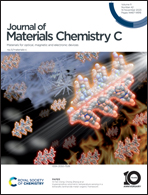Tailoring the mechanical properties of benzothiadiazole-based semiconducting polymers through chalcogen atom substitution†
Abstract
Benzothiadiazole (BT) is an organic heterocyclic compound characterized by a fused benzene and thiadiazole ring system with the ability to withdraw electrons due to the electronegative nitrogen and sulfur atoms in its structure. It is interesting as a building block for designing semiconducting donor–acceptor (D–A) copolymers, particularly remarkable candidates for organic electronics due to their optoelectronic properties, efficient charge transport capabilities, and good thermal stability. The versatility of BT allows for facile chemical modifications, enabling researchers to fine-tune the properties of semiconducting polymers and tailor their properties for specific application requirements. One strategy to unlock new possibilities and enhance the optoelectronic properties of BT-based polymers is through chalcogen substitution. By replacing the sulfur atom within the BT structure with heavier atoms such as selenium, which possesses stronger donating and polarizable properties, researchers can fine-tune the material's characteristics. However, the impact of extending the π-conjugated backbone and chalcogen atom substitution with a focus on the thermomechanical properties and molecular stretchability of D–A copolymers remains highly desirable in order to control their properties. In this work, a multimodal characterization strategy through various techniques was used to evaluate the properties of D–A copolymers prepared by co-polymerizing the 4,7-bis(5-bromo-4-octylthiophen-2-yl)-5,6-bis(octyloxy)benzo[c][1,2,5]thiadiazole acceptor unit with thiophene (P1), selenophene (P2), bithiophene (P3), and biselenophene (P4) as the donor units. Results showed that copolymers present lower Young's moduli, good performance in OFETs upon deformation, tunable charge transport, and suitable mechanical properties indicating their potential for emerging applications in stretchable organic semiconductors.



 Please wait while we load your content...
Please wait while we load your content...